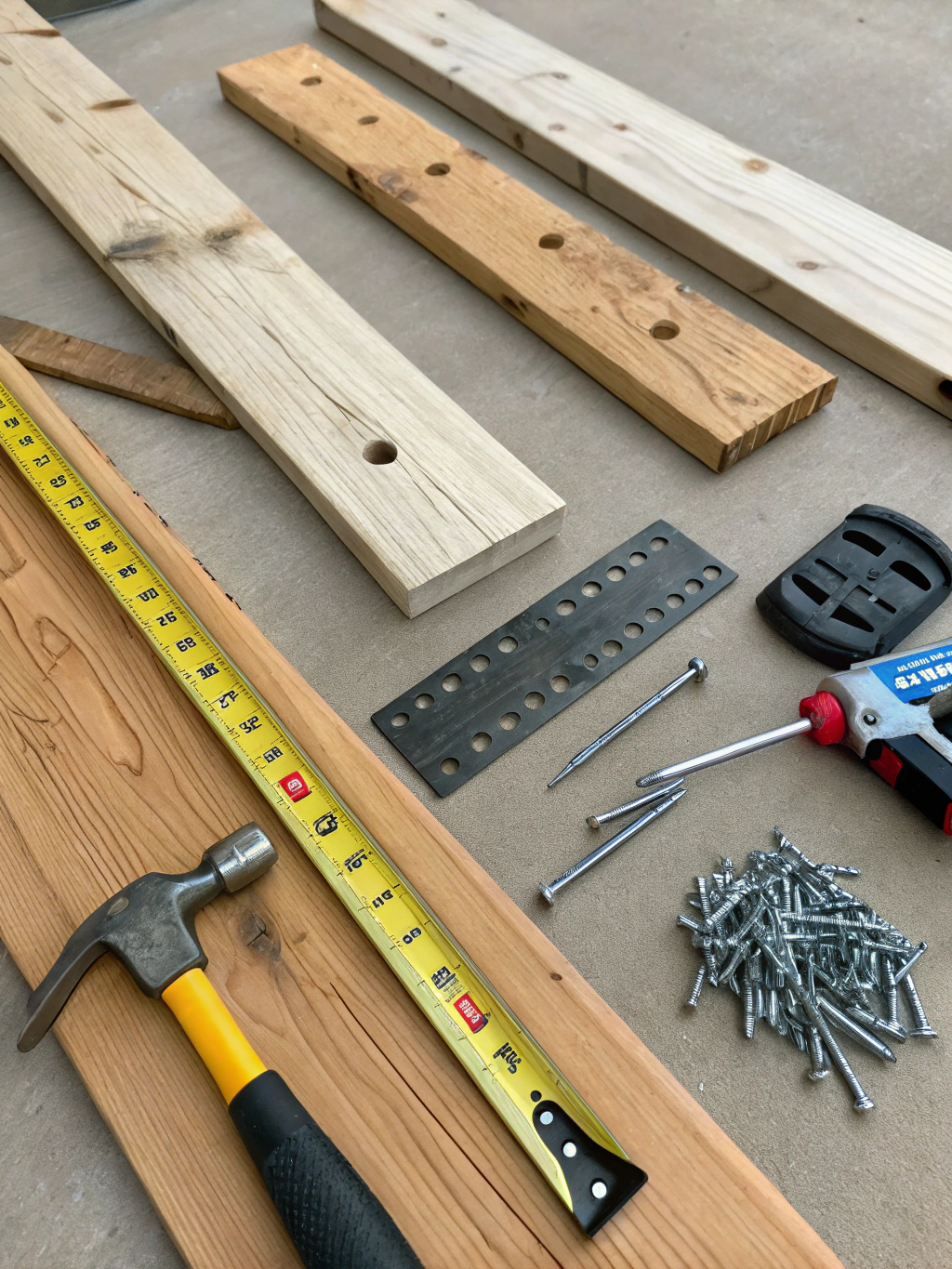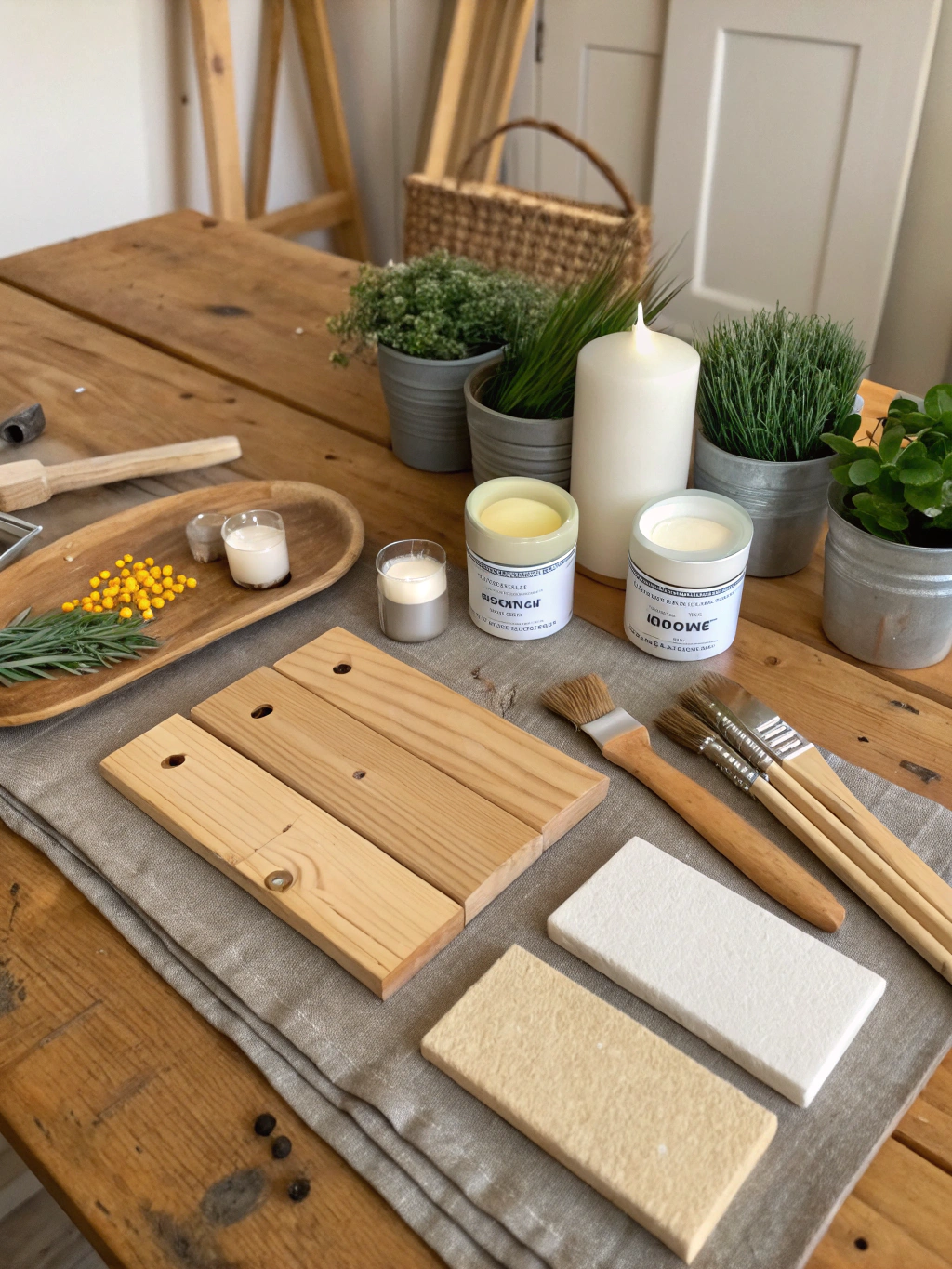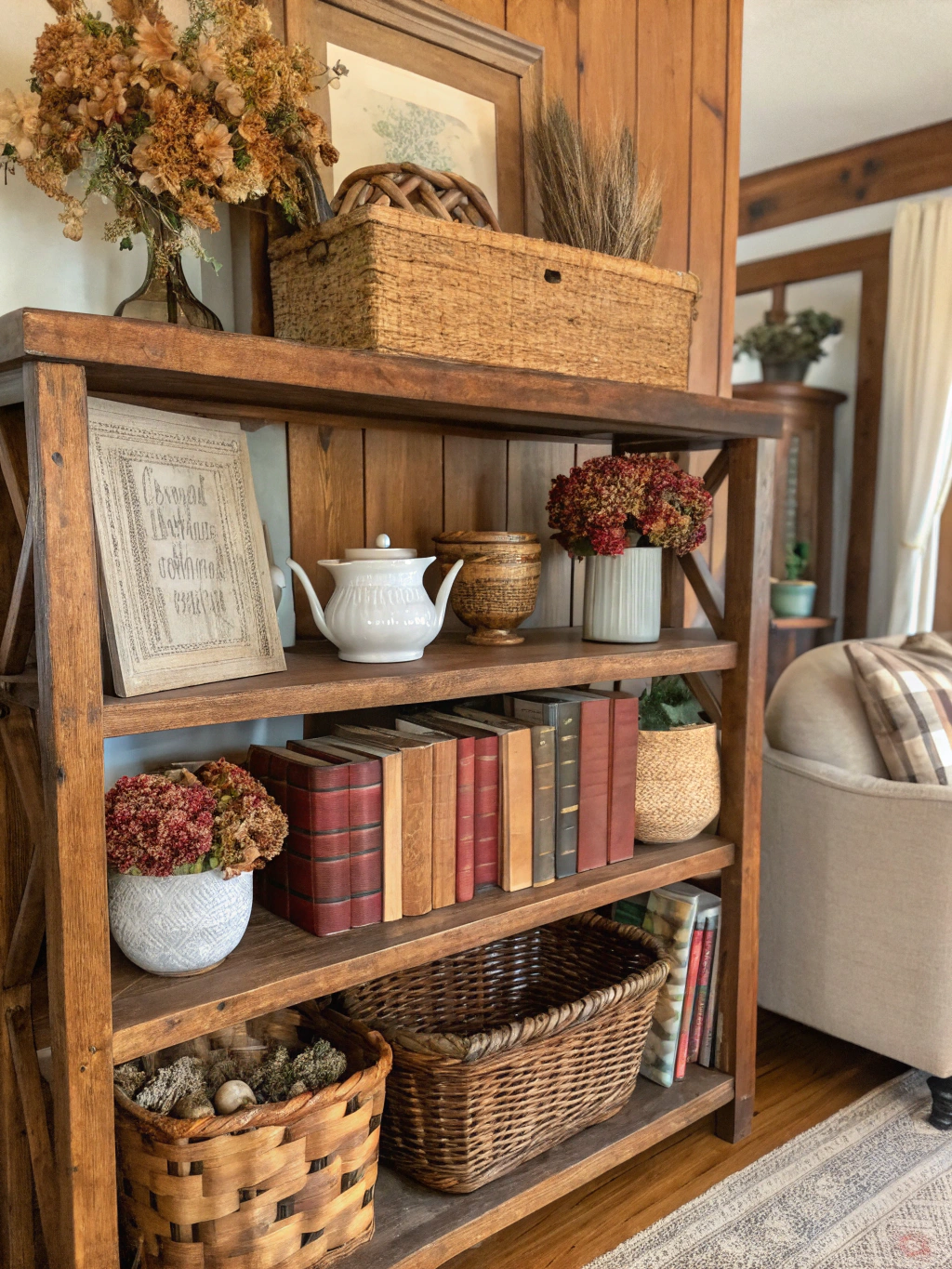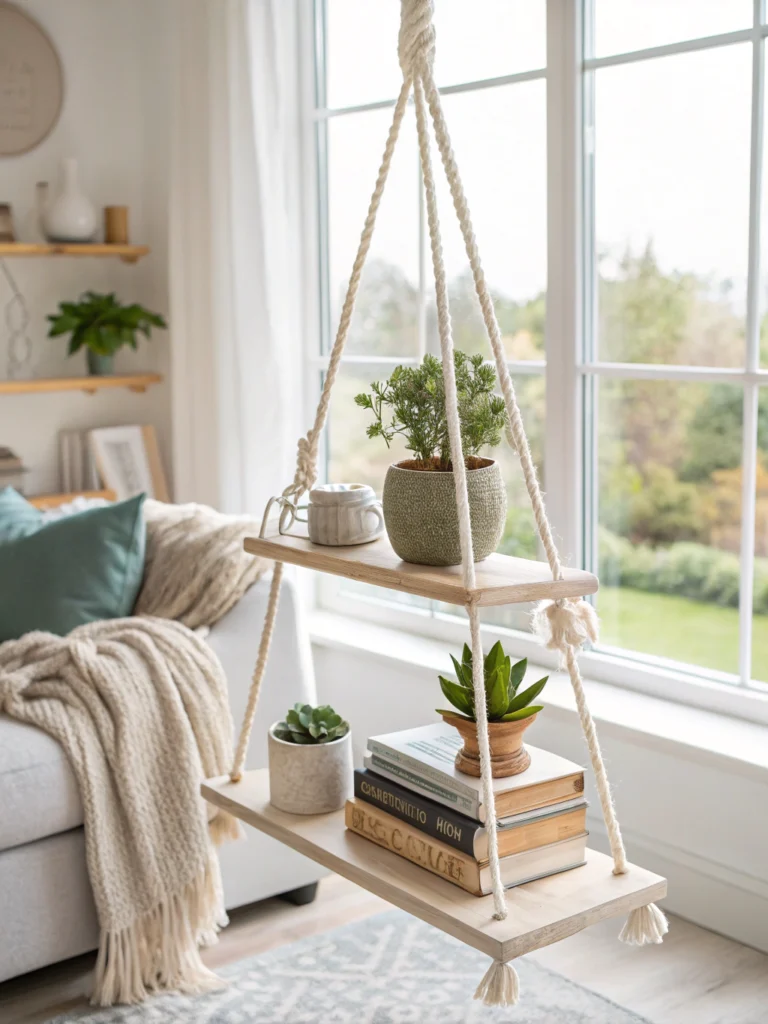Introduction
Ever scrolled through Pinterest, drooling over those gorgeous, rustic farmhouse interiors, and thought, “I wish I could have that, but it looks so complicated (and expensive!)”? Well, you’re in luck! Creating a stunning DIY farmhouse shelf is not only achievable but also surprisingly simple and budget-friendly. This project is perfect for adding a touch of cozy, rustic charm to any room in your home, whether it’s your living room, kitchen, bathroom, or even a hallway.
Forget complicated woodworking plans or needing a workshop full of fancy tools. We’re going to walk you through an easy-to-follow, 7-step guide that will have you admiring your handiwork in no time. Get ready to transform a few simple materials into a beautiful and functional piece of home décor that screams farmhouse chic!
The beauty of a DIY farmhouse shelf lies in its versatility and the personal touch you bring to it. Whether you’re a seasoned DIYer or a complete beginner looking for your first rewarding project, this guide is designed for you. We’ll cover everything from selecting your wood to the final finishing touches, ensuring you have all the information needed for a successful build. So, grab a cup of coffee, get inspired, and let’s start building a piece that will not only organize your space but also become a conversation starter.
Table of Contents
What You’ll Need
Before we dive into the fun part – the building – let’s gather all our supplies. Having everything ready beforehand makes the whole process smoother and much more enjoyable. Think of it as your DIY mise en place!

*Caption: All the essential materials and tools you’ll need to build your very own DIY farmhouse shelf.*
Materials:
- Wood Boards: The star of the show!
- One (1) 1×8 pine board, 6 feet long (for the main shelf and back support)
- One (1) 1×4 pine board, 4 feet long (for the shelf lip/front)
- Pro Tip: Look for boards with some character – knots and imperfections add to the rustic farmhouse charm! You can often find affordable options at your local home improvement store.
- Wood Screws:
- 1 ¼-inch wood screws (about 20-25)
- Wood Glue: A good quality wood glue is essential for a strong bond.
- Sandpaper: Various grits (e.g., 80, 120, and 220) for a smooth finish.
- Wood Stain or Paint: Your choice! A dark walnut stain or a distressed white paint are popular farmhouse choices.
- Polyurethane or Sealer (optional): To protect your shelf, especially if it’s going in a bathroom or kitchen.
- Shelf Brackets (optional, but recommended for heavier loads): Two decorative metal L-brackets if you plan on displaying heavier items. Ensure they match the farmhouse aesthetic.
- Picture Hanging Hardware (if not using brackets): Such as D-rings or a sawtooth hanger, depending on the shelf size and weight.
Tools:
- Measuring Tape: Accuracy is key!
- Pencil: For marking your cuts.
- Saw: A miter saw is ideal for clean, straight cuts, but a hand saw and miter box will also work.
- Drill/Driver: With drill bits and a countersink bit.
- Clamps: At least two, to hold pieces together while the glue dries.
- Safety Glasses: Always protect your eyes!
- Gloves (optional): Especially when staining.
- Paintbrushes or Rags: For applying stain or paint.
- Level: To ensure your shelf is perfectly horizontal when you hang it.
- Stud Finder: Crucial for secure wall mounting.
Now that we have our checklist, double-check you have everything. It’s no fun running to the store mid-project! Ready? Let’s get building!
Step-by-Step Guide to Your DIY Farmhouse Shelf
Alright, DIY enthusiasts, it’s time to roll up those sleeves and bring your DIY farmhouse shelf to life! Follow these seven easy steps, and you’ll be styling your new shelf before you know it. Remember, take your time, measure twice (cut once!), and enjoy the process. For further inspiration on “Farmhouse shelf plans, DIY farmhouse shelf tutorial, How to make a DIY farmhouse shelf”, you can check out some amazing ideas on HGTV’s DIY decor projects.
Step 1: Measure and Cut Your Wood
Precision is your best friend in this first crucial step. We’re aiming for a shelf that’s typically around 24-36 inches wide, but feel free to adjust this to your specific space and needs. For this tutorial, let’s aim for a 30-inch wide shelf.
- Main Shelf Board (from 1×8): Measure and mark one piece at 30 inches.
- Back Support Board (from 1×8): Measure and mark one piece at 30 inches. This will be the piece that attaches to the wall and supports the shelf from behind.
- Shelf Lip/Front (from 1×4): Measure and mark one piece at 30 inches. This piece adds a nice finished edge and a bit of extra stability.

*Caption: Step 1 of the DIY farmhouse shelf project: Carefully measuring and marking the wood boards before making cuts.*
Using your saw (miter saw preferred for accuracy, or hand saw with a miter box), carefully cut along your marked lines. Try to make your cuts as straight as possible. Don’t worry if they’re not absolutely perfect; the rustic nature of farmhouse style is quite forgiving! Once cut, lightly sand any rough edges with 80-grit sandpaper to prevent splinters.
Why this matters: Accurate cuts ensure all your pieces fit together snugly, creating a sturdier and more professional-looking shelf. A crooked cut now can lead to wobbly shelves later!
Common pitfalls: Rushing the cutting process can lead to misaligned pieces. Double-check your measurements before each cut. Using a dull saw blade can also result in splintered edges, so ensure your blade is sharp.
Step 2: Sand All Your Wood Pieces
Now that your pieces are cut to size, it’s time to give them a good sanding. This step is often underestimated, but it’s what separates a “homemade” look from a “handmade, high-quality” one.
Start with a coarser grit sandpaper (like 80 or 120-grit) to smooth out any saw marks, rough spots, and to slightly round over the sharp edges for a softer, more worn look. Follow up with a finer grit (like 220-grit) to achieve a silky-smooth finish that will take stain or paint beautifully. Always sand with the grain of the wood, not against it.
Wipe away all the sanding dust with a tack cloth or a slightly damp rag. You want a clean surface for the next steps.
Why this matters: Sanding not only improves the look and feel of your DIY farmhouse shelf but also helps the stain or paint adhere more evenly. It’s a bit of elbow grease that pays off big time in the final product.
Common pitfalls: Skipping grits (e.g., going straight from 80 to 220) can leave behind sanding marks. Not sanding enough, or sanding against the grain, can also result in a rough or blotchy finish. Don’t forget the edges and corners!
Step 3: Assemble the Shelf Base
This is where your DIY farmhouse shelf starts to take shape! We’ll be attaching the main shelf board (1×8 x 30 inches) to the back support board (also 1×8 x 30 inches).
Lay your back support board flat on your work surface. Apply a generous bead of wood glue along one of a long edge (the 30-inch edge). Now, take your main shelf board and place it perpendicular to the back support board, forming an “L” shape. The edge of the shelf board should sit flush on top of the glued edge of the back support. Ensure the ends are perfectly aligned.

*Caption: Step 3 in building your DIY farmhouse shelf: Gluing and screwing the main shelf piece to the back support.*
Once aligned, use clamps to hold the pieces firmly together. Then, pre-drill pilot holes through the bottom of the main shelf board and into the edge of the back support board. This prevents the wood from splitting. Drive in 1 ¼-inch wood screws approximately every 6-8 inches. For an even cleaner look, use a countersink bit so the screw heads sit slightly below the wood surface. You can fill these later with wood filler if desired.
Wipe away any excess glue that squeezes out with a damp cloth immediately.
Why this matters: This creates the fundamental structure of your shelf. The combination of glue and screws provides a very strong and durable joint.
Common pitfalls: Not using enough glue or screws, or not clamping the pieces securely while the glue sets, can result in a weak joint. Misaligning the boards can make the shelf look wonky.
Step 4: Attach the Front Lip
Next, we’ll attach the front lip (1×4 x 30 inches) to the front edge of the main shelf board. This piece adds visual depth and a nice finished look, preventing items from easily sliding off.
Apply wood glue along the front edge of the main shelf board (the 1×8 piece you just attached). Also, apply a little glue to the short ends of the front lip where it will meet the back support piece (if you want a super tight fit, though this اتصال is less structural). Position the 1×4 front lip against the glued edge of the shelf, ensuring its top edge is flush with the top surface of the shelf board. The bottom of the 1×4 will extend below the shelf, creating that “lip.”

*Caption: Step 4 for the DIY farmhouse shelf: Adding the front lip for a classic farmhouse look and extra stability.*
Clamp the front lip in place. Pre-drill pilot holes (and countersink if desired) through the front lip and into the edge of the main shelf board. Secure it with 1 ¼-inch wood screws, spaced about 6-8 inches apart. Again, wipe away any excess glue.
Allow the glue to dry completely according to the manufacturer’s instructions (usually a few hours, but 24 hours is best for maximum strength).
Why this matters: The front lip completes the basic construction of the shelf, adding both aesthetic appeal and a bit of functionality. It really drives home that classic “farmhouse shelf” look.
Common pitfalls: Attaching the lip crookedly. Ensure the top edge is perfectly flush with the shelf surface. Using screws that are too long can poke through the other side.
Finishing Your DIY Farmhouse Shelf
Step 5: Stain or Paint Your Shelf
Now for the fun part: making your shelf truly yours! This is where you get to choose the finish that best matches your décor. Popular farmhouse styles include a rich dark walnut stain, a weathered gray, or a classic distressed white paint.
If staining, apply the stain according to the product directions, usually with a brush or rag. Work in a well-ventilated area. Apply evenly, and wipe off any excess after a few minutes (the longer you leave it, the darker it gets). Allow it to dry completely. You might want to apply a second coat for a deeper color.
If painting, apply a primer first, especially if your wood has knots, to prevent bleed-through. Then, apply one or two coats of your chosen paint color. For a distressed look, once the paint is dry, you can lightly sand the edges and some flat surfaces with fine-grit sandpaper to reveal some of the wood underneath. This technique is key for achieving that coveted “Farmhouse shelf plans, DIY farmhouse shelf tutorial, How to make a DIY farmhouse shelf” aesthetic you often see in magazines.

*Caption: Step 5 in the DIY farmhouse shelf process: Applying your chosen stain or paint for that perfect farmhouse finish.*
Why this matters: The finish protects the wood and, more importantly, defines the style of your shelf. This step transforms it from a plain wooden structure to a piece of décor.
Common pitfalls: Applying stain or paint too thickly, which can lead to drips and an uneven finish. Not allowing enough drying time between coats. Forgetting to stir your stain or paint thoroughly before application.
Step 6: Apply a Sealer (Optional, but Recommended)
If your DIY farmhouse shelf is going to be in a high-moisture area like a bathroom or kitchen, or if you anticipate it getting a lot of wear and tear, applying a protective topcoat like polyurethane or a clear sealer is a wise move.
Choose a sealer that’s compatible with your stain or paint (e.g., water-based poly over water-based paint/stain, oil-based poly over oil-based). Apply one or two thin, even coats with a good quality brush, following the product instructions. Lightly sand with very fine-grit sandpaper (220 or higher) between coats (if recommended by the product) for an ultra-smooth finish. Make sure to wipe away sanding dust before applying the next coat.

*Caption: Step 6 in making your DIY farmhouse shelf: Sealing the wood for durability and longevity.*
Why this matters: A sealer protects your shelf from moisture, scratches, and stains, ensuring your hard work lasts for years to come.
Common pitfalls: Applying the sealer too thickly, which can result in a cloudy or bubbly finish. Not allowing adequate dry time. Using an incompatible sealer over your stain/paint.
Installing Your Masterpiece
Step 7: Hang Your DIY Farmhouse Shelf
The final step! It’s time to get your beautiful DIY farmhouse shelf up on the wall. Proper hanging is crucial for both safety and aesthetics.
First, decide where you want to hang your shelf. Use a stud finder to locate the wall studs. Whenever possible, screwing directly into studs is the most secure way to hang anything heavy. If studs aren’t conveniently located, you’ll need to use appropriate wall anchors designed for your wall type (drywall, plaster, etc.) and the weight of the shelf plus its contents.
If you’re using decorative L-brackets: Position the brackets on the wall where you want them, ensuring they are level with each other. Mark the screw holes, pre-drill, and attach the brackets to the wall (into studs if possible, or using heavy-duty anchors). Then, place your shelf on top of the brackets and secure it by screwing up through the brackets into the underside of the shelf.
If you’re directly mounting the shelf (best for lighter loads or if the back support is substantial): Hold the shelf against the wall in the desired position. Use a level to make sure it’s perfectly horizontal. Mark through the pre-drilled holes in your back support piece onto the wall. If you haven’t pre-drilled these mounting holes yet, do so now through the back support, ensuring they will hit studs or where you plan to put anchors. Drill pilot holes into the wall (or install anchors). Then, hold the shelf back up and screw it directly into the wall studs or anchors.

*Caption: Step 7 of your DIY farmhouse shelf project: Securely mounting the shelf to the wall.*
Stand back and admire your work! You’ve just built and installed your very own DIY farmhouse shelf.
Why this matters: Secure hanging prevents your shelf (and its precious contents) from crashing down. A level shelf also looks much more professional.
Common pitfalls: Not hitting studs or using inadequate anchors, leading to an unstable shelf. Hanging the shelf crooked – always use a level! Over-tightening screws into drywall anchors, which can strip them.
The Final Result: Your Cozy Farmhouse Charm!
Voilà! Take a moment to step back and truly appreciate the beautiful, functional, and charming DIY farmhouse shelf you’ve just created with your own two hands. It’s ready to be styled with your favorite books, plants, photos, or rustic knick-knacks to cozy up your space.

*Caption: Your completed DIY farmhouse shelf, beautifully styled and adding a warm, rustic touch to your home.*
This project not only adds a personal touch to your home décor but also gives you the satisfaction of making something unique. The beauty of DIY is that you can customize it perfectly to your taste and needs. Maybe you opted for a longer shelf, a different stain, or added some unique hardware – that’s what makes it special!
We’d absolutely love to see how your DIY farmhouse shelf turned out! Share a photo in the comments below, or tag us on social media. And if you have any tips or tricks you discovered along the way, please share those too – the DIY community thrives on shared knowledge! For more ideas or “Farmhouse shelf plans, DIY farmhouse shelf tutorial, How to make a DIY farmhouse shelf” details, resources like HGTV’s project galleries can be wonderfully inspiring.
Pro Tips & FAQs for Your DIY Farmhouse Shelf
To help you get the best possible result and answer some common questions, here are a few pro tips and FAQs:
(H3) Pro Tips:
- Wood Choice Matters: While pine is affordable and easy to work with, consider using reclaimed wood for an authentically rustic look. Pallet wood can also be a great option if properly prepped. Check out our guide on DIY farmhouse shelf projects using pallet wood for more ideas.
- Distressing Techniques: For an aged look, after painting, try gently hitting the shelf with a chain, or use a hammer and a bag of screws to create dents and dings before staining/painting. Vaseline applied to edges before painting can also create a chippy paint effect when sanded off.
- Customize the Size: Don’t feel constrained by the dimensions here. Measure your space and build a shelf that fits perfectly. Just remember to adjust material quantities accordingly.
- Hardware Finishes: Choose bracket colors and screw finishes (if visible) that complement your farmhouse style – matte black, antique brass, or oil-rubbed bronze are great choices.
- Test Stains: Always test your stain on a scrap piece of the same wood you’re using for your shelf. Stains can look very different depending on the wood type and its natural color.
(H3) FAQs (Collapsible Sections Recommended):
Q1: What’s the best wood to use for a DIY farmhouse shelf?
Pine is a popular choice because it’s affordable, readily available, and easy to work with. It also takes stain and paint well. For a more rustic or authentic farmhouse look, consider using reclaimed barn wood, cedar, or even well-sanded pallet wood. The key is to choose wood that has some character but is structurally sound.
Q2: How much weight can a DIY farmhouse shelf hold?
The weight capacity depends on several factors: the type of wood, the length of the shelf, the strength of the brackets (if used), and how securely it’s mounted to the wall. If screwed directly into wall studs, a well-built shelf like the one in this tutorial can typically hold 20-30 pounds distributed evenly. For heavier items, use stronger L-brackets and ensure they are anchored into studs.
Q3: How do I get that “distressed” farmhouse look on my shelf?
There are several techniques!
- Sanding: After painting, lightly sand the edges, corners, and a few flat spots to reveal the wood underneath or a base coat of a different color.
- Dry Brushing: Dip the very tips of your brush in a contrasting paint color (like white over a dark stain, or a darker color over light paint), wipe off most of the paint on a paper towel, then lightly drag the brush over the surface.
- Wax or Vaseline Resist: Apply wax or Vaseline to areas where you want the paint to chip before applying your topcoat. After the paint dries, gently rub or sand these areas, and the paint will easily come off.
- Physical Distressing: Before finishing, gently hit the wood with a chain, hammer, or other objects to create dents and dings for an aged appearance.
Explore various “Farmhouse shelf plans, DIY farmhouse shelf tutorial, How to make a DIY farmhouse shelf” online for visual guides on these techniques.
Q4: I’m a beginner. Is this DIY farmhouse shelf project too difficult for me?
Not at all! This project is designed to be beginner-friendly. The cuts are straight, the assembly is straightforward, and the farmhouse style is forgiving of minor imperfections. As long as you can measure, make simple cuts (or have them made at the hardware store), and use a drill, you can definitely tackle this. Take your time, follow the steps, and don’t be afraid to ask for help if you need it.
Q5: Where can I find good “Farmhouse shelf plans, DIY farmhouse shelf tutorial, How to make a DIY farmhouse shelf”?
You’re in the right place with this tutorial! Beyond this guide, many DIY blogs, Pinterest, and sites like HGTV offer a wealth of inspiration and plans. Look for projects that provide clear, step-by-step instructions and material lists. The key is to find a style and complexity that matches your skill level and vision for your space. Often, searching for “simple rustic shelf plans” or “easy farmhouse shelf tutorial” yields great beginner-friendly options.
We hope this comprehensive guide empowers you to create a beautiful DIY farmhouse shelf that you’ll love for years to come. It’s amazing what you can build with a few basic materials and a bit of creativity!
Ready to get building? If you have any more questions, or if you want to share your progress or your finished shelf, please drop a comment below! We love hearing from our fellow DIYers. Don’t forget to subscribe to our newsletter for more easy and inspiring home improvement projects, and share this tutorial with your friends who might love a touch of farmhouse charm in their homes! Happy building!


